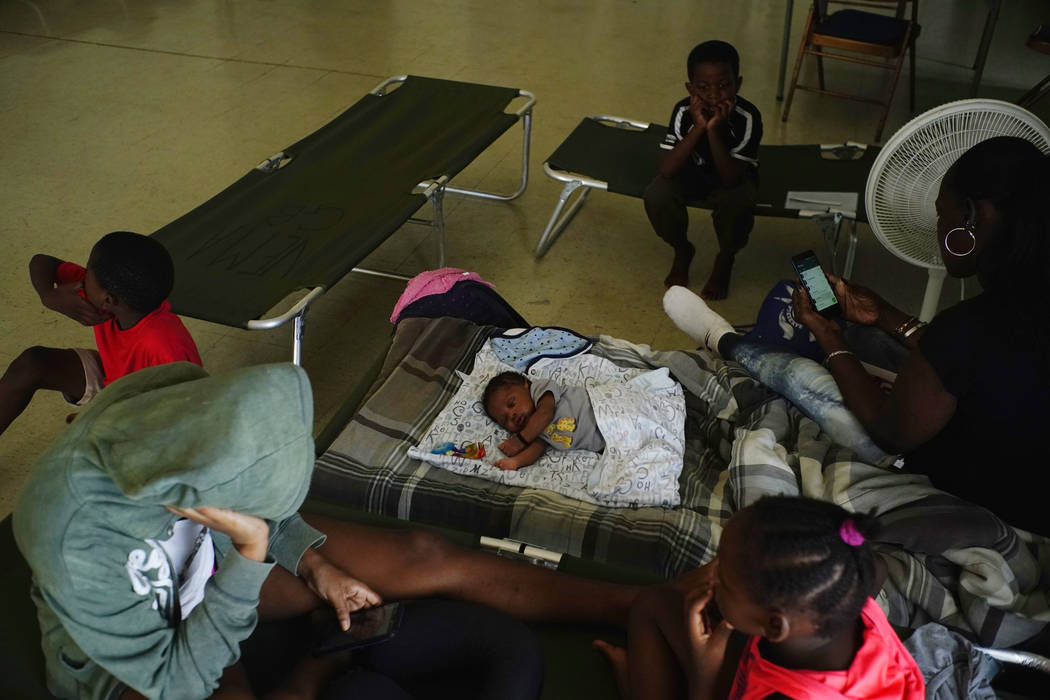Dorian slams into Bahamas as ‘devastating’ Category 5 hurricane
McLEAN’S TOWN CAY, Bahamas — Hurricane Dorian struck the northern Bahamas as a catastrophic Category 5 storm Sunday, its record 185 mph winds ripping off roofs, overturning cars and tearing down power lines as hundreds hunkered down in schools, churches and shelters.
Dorian slammed into Elbow Cay in Abaco island at 12:40 p.m., and then made a second landfall near Marsh Harbour at 2 p.m., after authorities made last-minute pleas for those in low-lying areas to evacuate.
“It’s devastating,” said Joy Jibrilu, director general of the Bahamas’ Ministry of Tourism and Aviation. “There has been huge damage to property and infrastructure. Luckily, no loss of life reported.”
The hurricane moved over the eastern end of Grand Bahama island during the night, with a slight decrease in its top winds to 180 mph, forecasters said. It was moving to the west at 6 mph.
Earlier Sunday, Dorian’s maximum sustained winds reached 185 mph, with gusts up to 220 mph. That tied it for the most powerful Atlantic hurricane ever to come ashore, equaling the Labor Day hurricane of 1935, before the storms were named.
There were indications that the slow-moving Dorian would veer sharply northeastward after passing the Bahamas and track up the U.S. Southeast seaboard. But authorities warned that even if its core did not make U.S. landfall, the potent storm would likely hammer the coast with powerful winds and heavy surf.
South Carolina Gov. Henry McMaster ordered a mandatory evacuation of the entire coast of the state amid Dorian’s threat. The order, which covers about 830,000 people, goes into effect at noon Monday, when state troopers will begin reversing lanes so they all head inland on major coastal highways.
“We can’t make everybody happy,” McMaster said. “But we believe we can keep everyone alive.”
Georgia’s governor, Brian Kemp, later ordered mandatory evacuations of that state’s Atlantic coast, also starting at midday Monday.
Authorities in Florida also ordered mandatory evacuations in some vulnerable coastal areas.

More than 600 Labor Day flights in the U.S. had been canceled as of Sunday afternoon, many of them in Florida as Dorian barreled toward the state’s coast.
The only recorded storm that was more powerful was Hurricane Allen in 1980, with 190 mph (305 kph) winds. That storm did not make landfall at that strength.
Battered Bahamas
“Catastrophic conditions” were reported in Abaco, with a storm surge of 18-23 feet, and Dorian was expected to cross Grand Bahama later in the day “with all its fury,” the center said.
In the northern stretches of the archipelago, hotels closed, residents boarded up homes and officials hired boats to move people to bigger islands.
Video that Jibrilu and government spokesman Kevin Harris said was sent by Abaco residents showed homes missing parts of their roofs, downed power lines and smashed and overturned cars. One showed floodwaters rushing through the streets of an unidentified town at nearly the height of a car roof.
In some parts of Abaco, “you cannot tell the difference as to the beginning of the street versus where the ocean begins,” said Prime Minister Hubert Minnis.
According to the Nassau Guardian, he called it “probably the most sad and worst day of my life to address the Bahamian people.”
Earlier, Minnis had warned that anyone who did not evacuate was “in extreme danger and can expect a catastrophic consequence.”
The government opened 14 shelters across the Bahamas. Dozens ignored evacuation orders, officials said.
“The end could be fatal,” said Samuel Butler, assistant police commissioner. “We ask you, we beg you, we plead with you to get to a place of safety.”

Over two or three days, the hurricane could dump as much as 4 feet of rain, in addition to the winds and storm surge, said private meteorologist Ryan Maue.
Harris, the government spokesman, said Dorian could affect 73,000 residents and 21,000 homes. Authorities closed airports for Abaco, Grand Bahama and Bimini, but Lynden Pindling International Airport in the capital of Nassau stayed open.
The archipelago is no stranger to hurricanes. Homes are required to have metal reinforcements for roof beams to withstand winds into the upper limits of a Category 4 hurricane, and compliance is generally tight for those who can afford it. Risks are higher in poorer neighborhoods, with wooden homes in low-lying areas.
Targeting U.S. coast
After the Bahamas, the slow-crawling storm was forecast to turn sharply and skirt toward the U.S. coast, staying just off Florida and Georgia on Tuesday and Wednesday and then buffeting South Carolina and North Carolina on Thursday.
The National Hurricane Center issued a hurricane watch for Florida’s East Coast from Deerfield Beach north to the Volusia and Brevard county line. The same area was put under a storm surge watch. Lake Okeechobee was under a tropical storm watch.

Florida Gov. Ron DeSantis warned the state’s densely populated Atlantic coast: “We’re not out of the woods yet.”
He suspended tolls on the Florida Turnpike and other roads, including Alligator Alley, from Fort Lauderdale to Naples, to keep traffic flowing for evacuees.
DeSantis noted some forecast models still bring Dorian close to or even onto the Florida peninsula.
Mandatory evacuation orders for low-lying and flood-prone areas and mobile homes were in effect starting either Sunday or Monday from Palm Beach County north to at least the Daytona Beach area, and some counties to the north issued voluntary evacuation notices. Weekend traffic was light in Florida despite those orders, unlike during the chaotic run-up to Hurricane Irma in 2017 when the unusually broad storm menaced the entire state.
President Donald Trump already declared a state of emergency and was briefed about what he called a “monstrous” storm.
“We don’t know where it’s going to hit but we have an idea, probably a little bit different than the original course,” Trump said. “But it can change its course again and it can go back more toward Florida.”
























